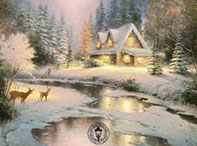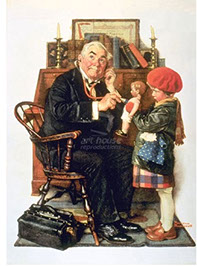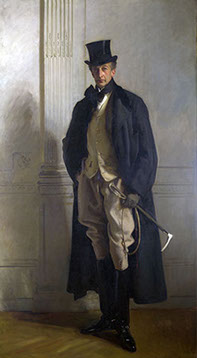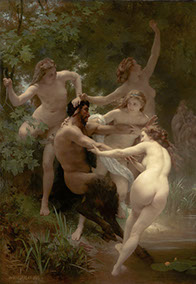updated Friday, Sunday, May 18, 2014
Kidding Around with Kitsch

Back in the good old days, the days of yore, before Global Warming and The War Against Women, kitsch was a hot topic on campus and cocktail parties. An Adventist Church seemed an unlikely venue. It seemed so to me. But it was at an Adventist Sabbath School class that I first heard of kitsch.
Actually, the class was taught, via PowerPoint, by a missionary fresh from academia, an enlightened Adventist PhD, who adjudged academic kitsch as of spiritual significance superseding that of the officially scheduled lesson on sanctification. After his kitsch shtick the learned doctor used the Sabbath School as a Film Festival in celebration of old, therefore sanctified, Hollywood flicks, permanently converting the class into a scholarly outpost. Mission accomplished, he returned to campus as a college president, which, I understand, went belly up. And 30 years later I’m still meditating on kitsch.
Now then, Kitsch is defined by Wikipedia (paraphrased, expanded) as that particular kind of low-brow art that relies on popular cultural icons, preferably patriotic and from Americana, and styles, necessarily outdated and from days of yore, necessarily mass-produced, and necessarily in bad taste, usually gaudy and garish, intended for, or unintentionally receiving, mass rather than critical appeal. The take home message: kitsch is bad taste. Bad Aesthetics, that’s the kitschword. “Tacky” and “camp” are, well, tacky equivalent adjectives. “Trashy,” “rubbish,” “decadent” aren’t quite equivalent and certainly like the kitschy ring.
In roughly that wording, Wikipedia gives the nitty-gritty of the definition of kitsch but not the kitschiness, the kinkiness, the aroma, the fisticuffs, the bullying without which you really cannot know what kitsch is. You must actually go and live there and mingle with the natives.
Now please welcome my current mentor, herr docktor C. vVolbortz, professor and chair of anthropology at large, as he recites the official Kitsch Manifesto, that he himself composed, after a lifetime of study. I have researched kitschology until cross-eyed, and this is inarguably the benchmark expression, the kitschsence of kitsch, and any other is anticlimax. Wikipedia, eat your heart out.
“The unifying characteristic, i.e., the defining element of this syndrome, is the fact that kitsch, feeding on the sentimentality of the larval stage human, strives to improve on nature by shaping it within the very narrow confines of its own immature capacity. Art, by contrast, is an expression that has been filtered through the human spirit. Kitsch is a manufacturing process and art is a creation. It stands to reason that kitsch also encompasses societal behavior and trends.” “Kitsch is very much like cancer.” Kitsch is “Culturally corrosive, evil.” "...Kitsch is the end of culture as we know it." [Al Gore may insist Global Warming is the worst threat to our security and our civilization and our planet, but he’s wrong: kitsch is.--wk] …
It is our task, we the artists, the poets, the healers, the musicians, to push back the infective forces of kitsch, to destroy this malignant prionic cultural protein, and to lead our society back to the road to cultural health. I have spoken!”
With this ringing in your ears, and maybe rendering you a little vertiginous, you just know that the study of kitsch, even the very word “kitsch,” originated in 19th century Germany despite the lack of PowerPoint, and remained unknown elsewhere for a century, until the 1970s and the invention of PowerPoint. And as it turns out, every kitschean I know, everyone worth his bratwurst, including, ahem, me, and my Sabbath School kitschicism teacher, is of Germanic origin. (But I’m not sure what bratwurst is.)
Though thoroughly akademisch now, at least in manifesto if not on blogs, Kitsch was conceived, born, and reared in the 19th century, the Golden Age of Uppitiness, in the Munich fine Art Market, where Kunstgaleriemeisters could be heard ejaculating to comparison shoppers, “Ghazzzsch! Sehr geehrter Herr meine, du nein zerious! Haf Du chust komen from der Herr Kitschelmann Galerie? Du deserven zo mud vedder zan zat! Vhy, das Kitschelmann, heafen forgife fer der menchionink hiz name, onzly ze schellen der Kitsch! Kitsch! Kvetch Kitsch! Eferyboty knowen zat!” Meanwhile, down der Kitschenstrasse Herr Kitschelmann is returning the compliment.
Kitsch can be anything I say it is, assuming I’m properly qualified, and armed, and of course I am. And it is also anything you say it is, although obviously you’re not properly qualified, except in arm wrestling. It can be anything anybody, if properly qualified (a PhD with a black belt will do), says it is. Instantly we are arm-wrestling all over the place, working up a sweat. Kitsch eat kitsch. Kitsch me if you can.
And thus the definition and rules, the tone and mood, the template and protocol, vocabulary and language (German), and style of combat, were set. But in the next century it evolved and mutated marvelously to include haute French or Sloane Street London English, and now de rigueur PowerPoint and ghetto academese -- but, dude, as long as I’m running this show, you use the f-word and you’re outta here. What remains iconic and unchanged since days of yore is the brawl.
Focused as it is on the low-brow, kitsch is only for the high-brow, aiming below the belt. If kitschy art is meant for mass consumption, the discussion sure isn’t. Kitsch must be one of the most chichi and hermitic of topics, knowable only by, and open only to, us priestly, professorial, blinkered-broadminded academic, and, oh yes, arty types, members only, curmudgeons only.
A kitsch tiff is no Platonic-Socratic Oxonian exercise in quiet logic or syllogism, nor rarefied interactive dialectic, nor respectful Olympian debate. It's more like two thus-speaking Zarathustras holding separate press conferences and issuing clashing communiques, or like two Zeuses hurling cosmic bolts of lightening at random, for the hell of it. Worse, it’s a Munich riot or Chicago street fight. Never to be heard in kitschticuffs are such sentiments as, “I respect your opinion,” or “I beg to differ.” No handshakes. Pleasurable frisson, one-upsmanship, cordial last-wordsmanship may be the ideal, with little poodles sniffing each other, but the reality on Kitschenstrasse is the dogfight, the duel. Sir, you fuming excrement, I have the honor to demand satisfaction! Choose your weapon! I choose the chuckle and the pun, no prisoners taken. Kitschy kitschy koo.
It’s supposed to be about art. Born of high-end art dealers’ disrespect of each other’s taste, kitsch is naturally and basically and obviously about art, notably painting, but logically includes any arty item whatsoever, culminating of course with movies (Kitsch Kong), and movie festivals, and awards. I wouldn't blurt this to that Sabbath School professor of long ago, but holding forth on kitsch in such a setting is kitschup 22 raised to the 22nd power and raising hell.
But of course kitsch can be anything at all, like kitschup sloshed over everything edible, as long as it’s about culture or sounds like it, and disses the uncultured. Scratch where it kitsches. So kitsch can be philosophy (e.g. Nietzsche kitsch) or places (Kitschican, Alaska; Kitschzakistan), literature (Updyke’s Witches of Eastkitsch) or music (Kitschaturian’s “Gayane Suit),” or cuisine (quiche kitsch), with painting getting aced clear out. Kitsch has moved from easel to whatever, from Munich to Hollywood and roars on into the wild blue yonder. Kitsch has gone global. And you can pop up with a kitsch quibble anywhere you want, blogs of course (kitsch is why blogs were invented), even Sabbath School. Sabbath school?
Moving on, then, to Kitschenstrasse, armed with Mace spray and brass knuckles. If debate or worse is so integral with kitsch that it's part of the definition, let's have one. The debating kitscheans, appearing and disappearing like pseudonomous bloggers, belittling each other’s taste with gusto. Don’t even try to keep them straight, nor guess who the antecedents might be.
In odd unanimity and collegiality, the calm before the storm, it begins with the flaying of a painter whose kitschosity is never questioned even on a blog, none other than the current personification of kitsch, the presiding patron saint of kitsch, the reigning King of Kitsch, Captain Thomas “Kitsch” Kinkaid.
If you know Kinkaid’s work you already know the definition of kitsch. As a kitschibitzer with subtle hair transplants insists, Kinkaid meets every major and minor criterion, whether of Wikipedia or Manifesto. Most famously he exploits the iconic Cozy cottage, festooned with Victorian Xmas lights reflecting upon the iconic fresh snow in the twilight. They call him “the painter of light.” Must be because he leaves every light bulb on in every room of every cottage, full blinding Watts. Isn’t that illegal nowadays -- iconically illegal? It’s hard to look at a Kinkaid cottage nestled in exactly 3” of snow as pure and fresh as special effects can make it, and not wince. The kitsch of the day!
A bearded old painter, herein designated the antagonist feels the urge to join the debate (speaking boldly in bold so you'll know it's him talking) now whirling around Kinkaid. Antagonist seems to be defending Kinkaid from the crime of kitschery. Poutingly, he says: But warmish incandescent kitsch is sure cozier than the new eco eerie blue government mandated fluorescents reflecting on the snow. KinKaid means well. When he’s all done, at the end of the day, in the twilight, with 3 inches of snow on the meadow, KinKaid hasn’t really destroyed painting, just made it a little sickening. He isn’t out to destroy culture as we know it, but to preserve and exalt it, in his kitschy way. Likewise core family, Western, American values, he’s not out to do them in. Anyway, Kinkaid’s skies, if not his cottages, are exceptionally finely painted. But, sigh, no contest, Mr. Kinkaid is Mr. Kitsch, still and forever.
The gray old painter remembers something else: Kinkaid wasn’t always the king, you know. I’m so old I remember when Norman Rockwell held the kitsch crown, all those cute little white kids and cute freckled white U.S. Army privates, doctors making housecalls and putting big old stethoscopes to doll’s hearts, roll-top desks, and every standing person male or female with advanced lordosis – lordy lordy! kitsch kitsch. No argument. But suddenly Rockwell has been adopted and apotheosized, and granted a waiver, by the very haute art critics that had kitschified him in the first place. I’m fine with that. Long live Rockwell.
The ancient one frowns and continues: But before Rockwell, even before Kinkaid, there was John Singer Sargent, whom the likes of Adam Gopnik have thrown into the rankest dungeon in all artdom without possibility of pardon, for the crime of not using his preternatural talent in behalf of Modernism. The charge of “kitsch” didn’t enter into Gopnik’s indictment, didn’t need to, contempt of Modernism being an even more heinous crime. Why isn’t anybody rebutting that?
A botoxed bushy-haired grad student smiles and asks, what’s to argue?, and suggests we boogey on to Bouguereau, proposing that Bouguereau (infamous for “Nymphs and Satyr”) is icky kitsch. No question about that, not because a nymph is as iconic as Rockwell’s prom girl at a soda fountain, but because Bouguereau was an academic painter. No other charges needed. Antagonist: You must be wrong! Isn’t being academic the opposite of kitsch? All things being equal, yes, indubitably. But academic painting is the exception. If being academic gives immunity from kitschism to everything else, in painting nothing is more kitschy. Sounds like kitsch 22.
A flag-stomping Protagonist pipes up: George Petty (aka George "Pinup" Petty) is a debased malignant corrosive corrupt icon exploiter. Antagonist: Never! George Petty's WWII pinups made life, American Values, and the nose gun turret of B17s, worth fighting for. Protagonist: Ha, you just made my case!
A pinstriped protagonist appears and asserts: Grandma Moses is kitsch, all those farm wagons. A helmeted conquischtador antagonist replies: Why you racist genderist and belittler abuser! Grandma was female and automatically gets a waiver from kitsch, and reparations. Pinstripe sighs, says: It's beginning to sound like Kinkaid is the only guaranteed politically safe kitsch.
Hieronymus Bosch is kitsch. He was the15th century Rockwell, you know. Bosh! The kitsch statute of limitations has expired, he’s sprung and beatified, like Rockwell.
Red Skelton's clown paintings are pure distilled red-nosed kitsch, from the days of yore. How wrong can you be! Skelton was a clown, transcending kitsch. Bob Hope was kitsch. No, he wasn’t, he couldn’t be; he made life, and American values, and all that, worth fighting for, and all that. Gotcha, again.
Sera Palin is malignant kitsch, as outdated as days of yore. No, Katy Couric is, that iconic Hillary hairdo and iconic gestures and heavy TV camera filtration, Katy Kitschuric. What does it matter, at this point?
Bratwurst is kitsch. Nein! It is der fodderland balues uber alles. What’s bratwurst?
Graffiti is deep kitsch, sumi calligraphy is not. You got that upside down, buddy.
Wedding cake couple is classic kitsch. No argument, buddy, but not gay wedding cake couples. A gay wedding cake couple is the new patriotism. One more peep from you and … .
Heroes are kitsch but celebrities aren’t? The Salvation army is kitsch but Obamacare isn’t? Freedom is Currier and Ives kitsch but liberation is now? You really really don’t want to go there, buddy. No, I really really don’t want to go there.
Bubble gum is kitsch. OK, buddy, sure, bubble gum is, but marijuana gum isn’t, it’s kewl and it’s what’s happening right now, which is the opposite of kitsch. “Kewl”? You mean cool?
“David” by Michelangelo is kitsch? You got it. It’s the fig leaf that makes it kitsch. Without the leaf, it’s the human condition, ergo opposite of kitsch. If you say that without the leaf David is obscene, you don’t know what true art is and why am I arguing with you?
Now an atheist in vested robe chants that Albrecht Duerer's “Praying Hands” is supplication to the great god of kitsch, isn’t it? Antagonist: I can’t talk about matters still undergoing an ongoing investigation.
A twitchy twerky lip-ringed individual texts into a smartphone that Jazz is keeeeezzzch, bro, so historic, so yesterday, way gone. Antagonist is offended: Why you pitiful little time warp! You want kitsch? Kitsch is a PowerPoint of over-photoschopped sunsets with poems off Hallmark cards and a schmaltzy muzak background. What’s muzak, bro?
Warhol and his Campbell’s soup cans must occupy a kitsch niche, right? Get a life, you old kitscher. If one connoisseur buys it for 190 million dollars, that isn’t kitsch. If 190 million consumers each buy it for $1.90, that’s kitsch. Warhol’s soup sold for more samolians than Campbells has cans.
Our antagonist now takes over: I'm getting your drift. But if you’re piqued by art that uses sweet old icons to make a few bucks, transgressive art must make you livid and quivering. It does me! With heads molded of the artist’s own blood, the virgin Mary with a halo of urine, and canned feces, transgressors like Andres Serrano exploit the commonest most banal things on the planet -- nothing can be more common and mass produced than feces, and in worse taste (I assume; I haven’t tasted it) -- for publicity and profit that puts Kinkaid.com to shame and in a different tax bracket. If a purring kitschy cat like Kinkaid simply exploits beloved icons of civility, a transgressor is hellbent on exploiting icons of commonness (as if no man had peed before) and exploding Civilization and defenestrating culture as we know it, just for the self-centered shock of it. It’s kitsch on steroids, worse, it’s genetically modified perversion, in your face. Doesn’t that trouble you? Why aren’t you calling 911?
And Please welcome, with a straight face if you can, straight from Hollywood, the award-winning star of “X-men Origins: Wolverine,” Mr. Taylor Kitsch! You made that up! That’s his Hollywood name. You mean Taylor “kitsch” Keechvichski, or something. I am not making this up. Kitsch is not his middle name, it’s his real name, the way his birth certificate reads. I’m a birther, I’ll check. If that is his real name, Hollywood should give the poor man a good virtual Hollywood name. Doesn't Hollywood catch it? No! Ho-Hol-Hollywood, the very capital and soul of kitsch, the mother of all kitsch, is blind to it's own distinction. Awards and Oscars are given for everything but what it does best and churns out like China does everything: kitsch. The place takes itself far too seriously. Hollywood doesn’t seem to have a clue that kitsch runs like a river through Mr. Kitsch and his movies. In all four of his reviews of Mr. Kitsch's kitchy movies, Roger Ebert keeps a straight face. Kitsch isn’t in his vocabulary. As close as Mr. Ebert gets to perceiving the kitschiness of Mr. Kitsch's name, is to acknowledge it as "Curious." Another Hollywood cover-up.
OK, OK, that wraps it up. That's all folks! And we never got around to Godzilla movies, Coca Cola, 1950s paintings of Santa Clauses, tattoos, T shirts, and Indian chiefs painted on velvet.

Kinkaid

Rockwell

Sargent

Grandma Moses

Petty Pinup

Bouguereau

